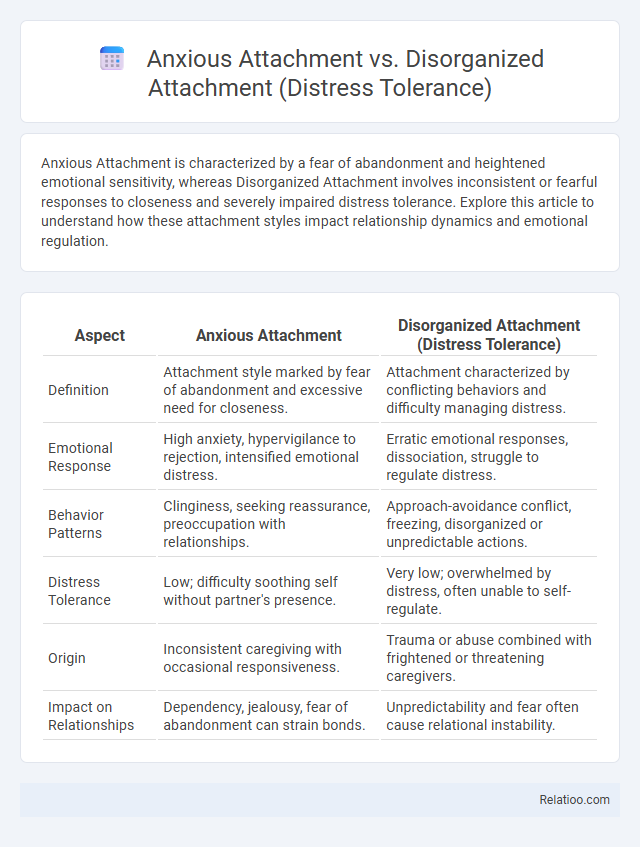Anxious Attachment is characterized by a fear of abandonment and heightened emotional sensitivity, whereas Disorganized Attachment involves inconsistent or fearful responses to closeness and severely impaired distress tolerance. Explore this article to understand how these attachment styles impact relationship dynamics and emotional regulation.
Table of Comparison
| Aspect | Anxious Attachment | Disorganized Attachment (Distress Tolerance) |
|---|---|---|
| Definition | Attachment style marked by fear of abandonment and excessive need for closeness. | Attachment characterized by conflicting behaviors and difficulty managing distress. |
| Emotional Response | High anxiety, hypervigilance to rejection, intensified emotional distress. | Erratic emotional responses, dissociation, struggle to regulate distress. |
| Behavior Patterns | Clinginess, seeking reassurance, preoccupation with relationships. | Approach-avoidance conflict, freezing, disorganized or unpredictable actions. |
| Distress Tolerance | Low; difficulty soothing self without partner's presence. | Very low; overwhelmed by distress, often unable to self-regulate. |
| Origin | Inconsistent caregiving with occasional responsiveness. | Trauma or abuse combined with frightened or threatening caregivers. |
| Impact on Relationships | Dependency, jealousy, fear of abandonment can strain bonds. | Unpredictability and fear often cause relational instability. |
Introduction to Attachment Styles
Anxious attachment is characterized by heightened sensitivity to rejection and a persistent need for reassurance, while disorganized attachment arises from inconsistent caregiving, leading to confusion and fear in relationships. Distress tolerance reflects your ability to endure emotional pain without becoming overwhelmed or resorting to maladaptive behaviors, which varies significantly across attachment styles. Understanding these distinctions provides crucial insight into how your early relational experiences shape your emotional regulation and interpersonal dynamics.
Understanding Anxious Attachment
Anxious attachment is characterized by a heightened sensitivity to relational rejection and an intense need for reassurance, often leading to emotional volatility and difficulty managing distress in close relationships. Unlike disorganized attachment, which involves conflicting behaviors and fear due to inconsistent caregiving, anxious attachment centers on fear of abandonment and hyperactivation of the attachment system. Developing distress tolerance skills can mitigate the emotional dysregulation seen in anxious attachment by promoting greater emotional resilience and reducing reactivity to perceived threats in interpersonal connections.
Exploring Disorganized Attachment
Disorganized attachment is characterized by inconsistent and erratic responses to stress, often resulting from early trauma or neglect, making it distinct from anxious attachment, which involves a heightened need for reassurance and fear of abandonment. Your ability to build distress tolerance may be more challenged in disorganized attachment due to fluctuating emotional responses and impaired self-regulation. Exploring disorganized attachment reveals patterns of confusion and fear in relationships, highlighting the importance of targeted therapeutic interventions to enhance emotional stability and coping mechanisms.
Core Differences Between Anxious and Disorganized Attachment
Anxious attachment is characterized by a heightened need for closeness and fear of abandonment, often leading to hypervigilance toward relational cues, whereas disorganized attachment involves contradictory behaviors and confusion during distress, stemming from fear without a clear strategy for comfort. Distress tolerance in anxious attachment tends to be lower due to intense emotional dependency, while individuals with disorganized attachment exhibit impaired distress tolerance linked to unresolved trauma and fear responses. Core differences include the underlying emotional regulation patterns: anxious attachment manifests as consistent anxiety and pursuit, while disorganized attachment reflects disoriented responses and difficulty managing fear during stressful interactions.
Distress Tolerance in Anxious Attachment
Distress tolerance in Anxious Attachment involves difficulty managing emotional discomfort, leading to heightened anxiety and fear of abandonment. Unlike Disorganized Attachment, which combines fear and confusion in close relationships, Anxious Attachment primarily triggers intense longing for reassurance, making distress tolerance crucial for emotional regulation. Improving your distress tolerance can help mitigate the impact of anxiety-driven behaviors and foster healthier connections.
Distress Tolerance in Disorganized Attachment
Disorganized attachment is characterized by inconsistent and confused responses to stress, leading to impaired distress tolerance compared to anxious attachment, which involves heightened emotional reactivity but more predictable coping strategies. Individuals with disorganized attachment often experience fragmented regulatory mechanisms, resulting in a compromised ability to manage intense emotional distress effectively. This diminished distress tolerance makes emotional regulation challenging, increasing vulnerability to maladaptive behaviors and psychological disorders.
Impact on Interpersonal Relationships
Anxious attachment often leads to heightened sensitivity to rejection and a persistent need for reassurance, causing challenges in forming stable interpersonal relationships. Disorganized attachment combines fear and confusion, resulting in inconsistent behaviors that disrupt trust and emotional closeness with others. Your ability to develop distress tolerance skills directly influences how effectively you manage emotional turmoil, fostering healthier and more resilient connections.
Emotional Regulation Strategies
Anxious attachment involves heightened sensitivity to rejection and a persistent need for reassurance, often leading to emotional dysregulation and ineffective distress tolerance. Disorganized attachment combines elements of both anxious and avoidant patterns, resulting in chaotic emotional responses and impaired ability to regulate distress due to conflicting internal models of caregivers. Effective emotional regulation strategies for both attachment styles include mindfulness-based techniques, cognitive reappraisal, and grounding exercises to enhance distress tolerance and promote stable affect management.
Therapeutic Approaches for Each Attachment Style
Therapeutic approaches for anxious attachment prioritize building emotional regulation skills and fostering secure connections through consistent, empathic validation and cognitive-behavioral interventions to reduce hypervigilance and reassurance-seeking behaviors. In contrast, treatment for disorganized attachment emphasizes trauma-informed therapy, including somatic experiencing and attachment-focused EMDR, to integrate fragmented self-states and enhance distress tolerance by developing safety and self-soothing mechanisms. Distress tolerance techniques, such as Dialectical Behavior Therapy (DBT), psychoeducation on emotional modulation, and mindfulness practices, are tailored to improve clients' capacity to endure emotional pain without impulsive reactions, regardless of attachment style.
Building Healthy Coping Mechanisms
Anxious attachment often leads to heightened emotional responses and difficulty managing stress, while disorganized attachment is characterized by inconsistent behaviors and struggles with regulating emotions during distress. You can build healthy coping mechanisms by developing self-soothing techniques, mindfulness practices, and seeking therapy focused on distress tolerance skills. Strengthening these abilities promotes emotional resilience and healthier interpersonal relationships despite attachment challenges.

Infographic: Anxious Attachment vs Disorganized Attachment (Distress Tolerance)
 relatioo.com
relatioo.com